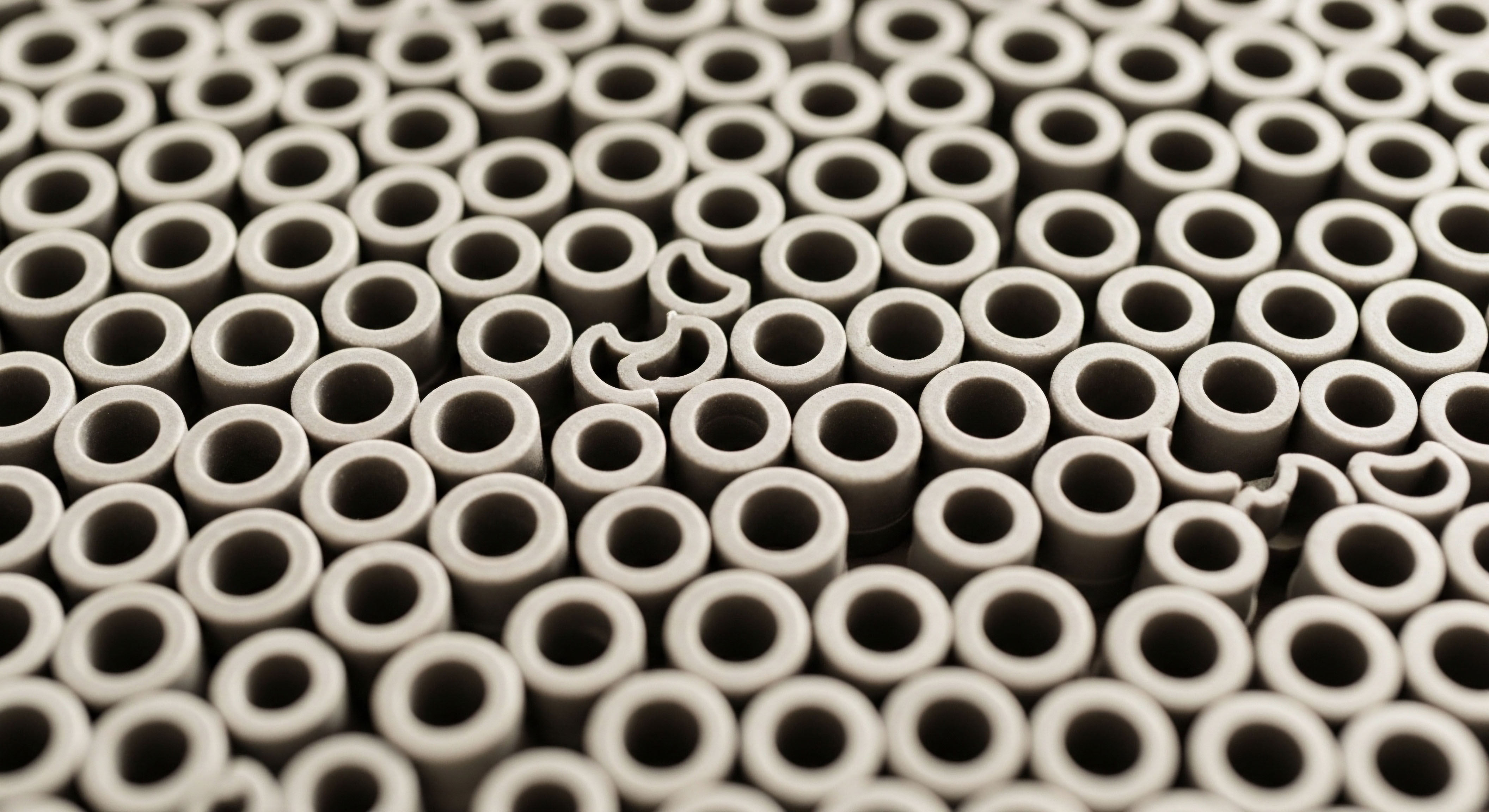

Fundamentals
Have you ever felt as though your body is operating on a different wavelength, where familiar rhythms of vitality have been replaced by an unsettling discord? Perhaps you experience unpredictable shifts in mood, persistent fatigue that no amount of rest seems to resolve, or menstrual cycles that have become a source of confusion rather than a predictable pattern.
These sensations are not merely isolated incidents; they are often whispers from your internal systems, signaling a deeper conversation happening within your endocrine network. Many individuals grappling with such symptoms often feel dismissed or misunderstood, as if their experiences are subjective rather than rooted in biological realities.
Understanding your body’s intricate communication systems is the first step toward reclaiming a sense of balance and well-being. This understanding begins with recognizing the profound connection between your stress response system and your reproductive health.
The question of whether modulating the hypothalamic-pituitary-adrenal axis (HPA axis) can directly enhance the efficacy of female hormone protocols is not a simple query; it opens a window into the complex, interconnected nature of your physiology. It invites us to consider how the body’s primary mechanism for handling stress influences the very hormones that govern female vitality and function.
Your body’s internal signals, like mood shifts or irregular cycles, often point to deeper biological conversations within your endocrine system.

The Body’s Internal Thermostat
Imagine your body as a meticulously designed home, complete with various systems working in concert to maintain optimal conditions. The HPA axis functions much like a central thermostat, constantly monitoring and adjusting your internal environment in response to perceived challenges.
This neuroendocrine system is a sophisticated network involving three key components ∞ the hypothalamus, a region in your brain that initiates the stress response; the pituitary gland, which acts as a relay station; and the adrenal glands, small organs situated atop your kidneys that produce stress hormones.
When a challenge arises, whether it is a demanding work schedule, emotional strain, or even insufficient sleep, the hypothalamus releases corticotropin-releasing hormone (CRH). This chemical messenger travels to the pituitary gland, prompting it to release adrenocorticotropic hormone (ACTH). ACTH then signals the adrenal glands to produce and release cortisol, often referred to as the body’s primary stress hormone.
Cortisol plays a vital role in short-term survival, mobilizing energy reserves, sharpening focus, and modulating inflammatory responses. It is a powerful agent designed to help you navigate immediate challenges. However, when this system remains perpetually activated due to chronic, unremitting challenges, the sustained elevation of cortisol can begin to disrupt other delicate hormonal balances throughout the body.
This continuous demand on the HPA axis can lead to a state of dysregulation, where the system struggles to return to a state of calm and equilibrium.

Female Hormones and Stress Response
The female endocrine system, with its rhythmic fluctuations of estrogen and progesterone, is particularly sensitive to the influence of the HPA axis. These two systems are not isolated; they engage in a continuous, bidirectional dialogue. Estrogen, for instance, can significantly influence HPA axis activity.
Research indicates that different estrogen receptors, specifically estrogen receptor alpha (ERα) and estrogen receptor beta (ERβ), play distinct roles in this modulation. ERα activation can stimulate HPA axis activity, while ERβ activation may exert an inhibitory effect, particularly when the HPA axis is already activated. This intricate interplay means that the levels and balance of estrogen can directly impact how your body perceives and responds to challenges.
Progesterone also holds a significant position in this hormonal conversation. It is not solely a reproductive hormone; it functions as a neurosteroid, influencing brain activity and stress resilience. Progesterone converts into allopregnanolone (ALLO), a neurosteroid that interacts with gamma-aminobutyric acid (GABA) receptors in the brain.
GABA is the primary inhibitory neurotransmitter, responsible for calming neural activity. By enhancing GABAergic transmission, allopregnanolone helps to quiet the nervous system, thereby stabilizing the HPA axis and improving the body’s capacity to cope with challenges. This calming influence underscores progesterone’s role in mitigating the impact of stress on overall well-being.
The HPA axis, your body’s stress response system, profoundly influences female hormones, with estrogen and progesterone playing key roles in its regulation.

The Impact of Chronic Stress on Female Physiology
When the HPA axis is chronically overstimulated, the sustained production of cortisol can create a cascade of effects that ripple through the female reproductive system. The body, in its wisdom, prioritizes survival over reproduction when faced with persistent challenges.
This prioritization can lead to a suppression of the hypothalamic-pituitary-gonadal axis (HPG axis), the primary control center for reproductive hormones. Cortisol can directly inhibit the release of gonadotropin-releasing hormone (GnRH) from the hypothalamus. GnRH is the crucial signal that prompts the pituitary gland to release luteinizing hormone (LH) and follicle-stimulating hormone (FSH), which in turn regulate ovarian function, including ovulation and the production of estrogen and progesterone.
This suppression can manifest in various ways, impacting menstrual regularity and fertility. Many individuals experiencing chronic challenges report irregular or missed menstrual periods, a direct consequence of disrupted ovulation. Beyond cycle irregularities, sustained HPA axis activation can also contribute to other common concerns.
For instance, it can worsen symptoms associated with Polycystic Ovary Syndrome (PCOS) by exacerbating insulin resistance and increasing androgen levels. Similarly, for individuals navigating the menopausal transition, elevated cortisol levels can intensify symptoms such as hot flashes, sleep disturbances, and mood changes, making an already significant life transition even more challenging.
Understanding these foundational connections provides a clearer picture of why addressing the HPA axis is not merely an auxiliary consideration but a central component in optimizing female hormone protocols. It shifts the perspective from simply treating symptoms to recalibrating the underlying biological systems for lasting vitality.


Intermediate
Moving beyond the foundational understanding of the HPA axis and its interaction with female hormones, we can now consider how clinical protocols specifically address this intricate relationship. The objective is not simply to administer hormones, but to create an environment where the body’s own regulatory systems can function optimally, thereby enhancing the efficacy of any hormonal optimization strategy. This involves a thoughtful consideration of how stress hormones influence the reception and utilization of administered female hormone protocols.

Targeting HPA Axis Dysregulation
Addressing HPA axis dysregulation is a multi-pronged approach, often involving lifestyle modifications, targeted nutritional support, and, in some cases, specific therapeutic agents. The goal is to reduce the chronic activation of the stress response, allowing the body to re-establish a more balanced hormonal milieu.
- Stress Reduction Techniques ∞ Implementing practices such as deep breathing exercises, mindfulness, and regular, moderate physical activity can significantly influence HPA axis activity. These techniques help to activate the parasympathetic nervous system, which counteracts the “fight or flight” response, thereby lowering cortisol levels and promoting a state of rest and repair.
- Nutritional Support ∞ Specific nutrients play a vital role in supporting adrenal function and neurotransmitter balance. B vitamins, magnesium, and vitamin C are essential cofactors for hormone synthesis and stress resilience. A diet rich in whole, unprocessed foods helps stabilize blood sugar, which in itself reduces a significant physiological stressor on the HPA axis.
- Adaptogenic Herbs ∞ Certain botanical compounds, known as adaptogens, have demonstrated the capacity to modulate the HPA axis, helping the body adapt to challenges without overreacting. Ashwagandha (Withania somnifera) is a well-researched adaptogen that has shown promise in reducing cortisol levels, particularly morning cortisol, and improving stress resilience. Other adaptogens like Rhodiola and Holy Basil also contribute to balancing the stress response.

Female Hormone Protocols and HPA Axis Sensitivity
When considering female hormone protocols, such as Testosterone Replacement Therapy (TRT) for women or progesterone supplementation, the state of the HPA axis is a critical determinant of treatment success. Administering hormones into a system already under significant stress can sometimes lead to suboptimal outcomes or even exacerbate certain symptoms if the underlying HPA axis dysregulation is not addressed.
For instance, in women, Testosterone Cypionate is typically administered in low doses, often 10 ∞ 20 units (0.1 ∞ 0.2ml) weekly via subcutaneous injection, to address symptoms like low libido, fatigue, and mood changes. While testosterone itself can have a positive impact on mood and energy, its efficacy can be diminished if the body is simultaneously grappling with chronic, elevated cortisol. High cortisol levels can influence the sensitivity of hormone receptors or alter the metabolic pathways of administered hormones, potentially reducing their desired effects.
Similarly, Progesterone, prescribed based on menopausal status, is a cornerstone of female hormone balance. Its role in calming the nervous system via allopregnanolone production makes it uniquely positioned to support HPA axis health. When progesterone levels decline, particularly during perimenopause, the HPA axis can become destabilized, leading to increased anxiety, sleep disturbances, and a reduced capacity to cope with challenges.
Supplementing progesterone can therefore not only address reproductive symptoms but also directly contribute to HPA axis stability, creating a more receptive environment for other hormonal interventions.
Optimizing female hormone protocols requires addressing HPA axis health, as chronic stress can diminish the effectiveness of administered hormones.

Oral versus Transdermal Estrogen and Cortisol
The method of hormone administration can also influence the HPA axis. Research indicates a notable difference between oral and transdermal estrogen preparations regarding their impact on cortisol levels. Oral estrogen, due to its “first-pass” metabolism through the liver, can significantly increase levels of cortisol-binding globulin (CBG).
CBG is a protein that binds to cortisol, making it inactive. While total cortisol levels may appear higher on blood tests with oral estrogen, the amount of biologically active, “free” cortisol may not be significantly altered.
Conversely, transdermal estradiol (patches or creams) bypasses this initial liver metabolism and does not appear to have the same effect on CBG or total cortisol levels. This distinction is important for individuals with pre-existing HPA axis dysregulation or those sensitive to cortisol fluctuations. Choosing a transdermal route for estrogen replacement might be a more favorable option for some, minimizing potential interactions with the stress response system.
How Does HPA Axis Modulation Influence Hormone Receptor Sensitivity?
The interaction between the HPA axis and female hormone protocols can be summarized in the following table, highlighting key considerations for clinical practice:
| Hormone/Intervention | Primary Role in Female Protocols | HPA Axis Interaction | Clinical Consideration for Efficacy |
|---|---|---|---|
| Estrogen (Transdermal) | Addresses hot flashes, vaginal atrophy, bone density, mood. | Minimal direct impact on CBG; supports HPA axis stability via ERβ. | Generally preferred for HPA axis sensitivity; direct receptor action. |
| Estrogen (Oral) | Addresses similar symptoms, but with liver first-pass effect. | Increases CBG, potentially raising total cortisol; may influence HPA axis indirectly. | Monitor total vs. free cortisol; consider individual HPA axis resilience. |
| Progesterone | Supports uterine lining, sleep, mood, anxiety reduction. | Converts to allopregnanolone, calming GABA receptors and stabilizing HPA axis. | Essential for HPA axis support; can improve stress coping and sleep. |
| Testosterone (Female Dose) | Improves libido, energy, mood, muscle mass. | Can be influenced by high cortisol; optimal HPA axis function supports receptor sensitivity. | Address HPA axis dysregulation first for optimal testosterone utilization. |
| Adaptogens (e.g. Ashwagandha) | Support stress resilience, reduce cortisol. | Directly modulate HPA axis, promoting balance and reducing overactivity. | Complementary to hormone protocols; creates a more receptive internal environment. |
This integrated approach, which considers the state of the HPA axis alongside specific hormone replacement strategies, allows for a more personalized and effective path toward hormonal balance and overall well-being. It acknowledges that the body operates as a unified system, where the health of one axis profoundly influences the function of another.


Academic
The exploration of HPA axis modulation as a means to enhance female hormone protocols demands a rigorous, systems-biology perspective. The intricate dialogue between the HPA axis and the hypothalamic-pituitary-gonadal axis (HPG axis) is not merely additive; it represents a complex feedback loop where dysregulation in one system can profoundly alter the function and responsiveness of the other. This section delves into the deeper endocrinological mechanisms, drawing upon clinical research and the molecular underpinnings of these interactions.

Neuroendocrine Crosstalk and Receptor Dynamics
The central nervous system orchestrates the activity of both the HPA and HPG axes through a sophisticated network of neurotransmitters and neuropeptides. Corticotropin-releasing hormone (CRH), the primary hypothalamic driver of the HPA axis, directly inhibits the pulsatile release of gonadotropin-releasing hormone (GnRH) from the hypothalamus.
This suppression of GnRH, in turn, reduces the pituitary’s secretion of luteinizing hormone (LH) and follicle-stimulating hormone (FSH), leading to diminished ovarian steroidogenesis ∞ the production of estrogen and progesterone. This direct inhibitory pathway explains how chronic stress, by maintaining elevated CRH and cortisol, can lead to conditions such as hypothalamic amenorrhea or exacerbate hormonal imbalances observed in perimenopause.
Conversely, gonadal steroids exert significant influence over the HPA axis. Estrogen, through its interaction with both ERα and ERβ, can modulate CRH and ACTH secretion. ERα activation generally potentiates HPA axis activity, increasing basal corticosterone levels and enhancing stress responsiveness. ERβ, however, appears to mediate an inhibitory effect, particularly under conditions of acute stress.
The balance between these receptor subtypes, which can be influenced by the specific estrogenic compounds present and their concentrations, dictates the overall impact on the HPA axis. Progesterone, through its metabolite allopregnanolone (ALLO), acts as a positive allosteric modulator of GABAA receptors, increasing chloride ion influx and hyperpolarizing neurons.
This enhanced GABAergic tone directly inhibits CRH neurons in the paraventricular nucleus (PVN) of the hypothalamus, thereby dampening HPA axis output and promoting a state of calm. The decline in progesterone during perimenopause, therefore, directly contributes to HPA axis destabilization and increased stress sensitivity.
What Are the Molecular Mechanisms Underlying HPA Axis Influence on Ovarian Steroidogenesis?

Metabolic Intersections and Glucocorticoid Resistance
The interplay extends beyond direct neuroendocrine signaling to encompass metabolic pathways. Chronic HPA axis activation and sustained high cortisol levels are intimately linked with metabolic dysregulation, including insulin resistance, altered glucose metabolism, and visceral adiposity. These metabolic shifts can further compromise the efficacy of female hormone protocols. For example, insulin resistance can impair ovarian function, contributing to anovulation and hyperandrogenism in conditions like PCOS, even when exogenous hormones are administered.
Moreover, prolonged exposure to high glucocorticoid levels can lead to a phenomenon known as glucocorticoid resistance at the cellular level. This means that target tissues, including those responsive to female hormones, may become less sensitive to the signaling of both endogenous and exogenous steroids.
The glucocorticoid receptor (GR) itself can undergo changes in expression or phosphorylation, altering its binding affinity and downstream gene transcription. If the GR is desensitized, the negative feedback loop that normally regulates HPA axis activity becomes impaired, perpetuating a cycle of hypercortisolemia. This desensitization can also extend to other steroid hormone receptors, potentially reducing the effectiveness of administered estrogen or testosterone.
Consider the implications for therapeutic strategies. If a patient presents with symptoms of hormonal imbalance alongside evidence of chronic HPA axis overactivity, simply prescribing hormone replacement without addressing the stress response may yield suboptimal results. The body’s cellular machinery might not be optimally primed to receive and respond to the administered hormones.

Peptide Modulators of the HPA Axis
The field of peptide science offers intriguing avenues for HPA axis modulation, potentially enhancing the receptivity to female hormone protocols. Peptides are short chains of amino acids that act as signaling molecules, often with highly specific actions on receptors or enzymatic pathways.
Some peptides directly influence the HPA axis at various levels:
- CRH-Modulating Peptides ∞ Peptides that can reduce CRH release from the hypothalamus or block its receptors could theoretically dampen HPA axis overactivity. For instance, certain neuropeptides found in the central nervous system are known to inhibit CRH neurons.
- ACTH-Influencing Peptides ∞ Peptides that affect ACTH secretion from the pituitary could also be relevant. While some peptides, like Neuropeptide S, have been shown to stimulate ACTH release, others might have inhibitory effects.
- Adrenal Steroidogenesis Modulators ∞ Peptides influencing the enzymes involved in cortisol synthesis within the adrenal glands could offer another point of intervention. For example, Galanin-like peptide (Galp) and alarin (Ala) have been shown to affect the expression of steroidogenesis enzymes like cholesterol desmolase (Cyp11a1).
The use of specific peptides, such as Sermorelin or Ipamorelin/CJC-1295, primarily targets growth hormone release, but an indirect benefit on HPA axis function could be hypothesized through improvements in sleep quality and overall metabolic health, which are known to influence stress resilience.
While direct evidence of these specific growth hormone-releasing peptides modulating the HPA axis to enhance female hormone protocols is still an area of active research, the broader concept of using targeted peptides to optimize systemic physiology holds considerable promise.
What Are the Long-Term Physiological Consequences of Unaddressed HPA Axis Dysregulation on Female Endocrine Health?
The integration of HPA axis modulation into female hormone protocols is not a superficial addition; it is a fundamental recalibration of the body’s internal environment. By addressing the root causes of stress-induced physiological imbalance, clinicians can create a more harmonious internal landscape, allowing female hormone protocols to exert their intended effects with greater precision and efficacy.
This comprehensive approach acknowledges the profound interconnectedness of the endocrine system, moving beyond simplistic hormone replacement to a truly personalized and systems-based strategy for well-being.
| HPA Axis Component | Role in Stress Response | Interaction with Female Hormones | Implication for Protocols |
|---|---|---|---|
| Hypothalamus (CRH) | Initiates stress response; releases CRH. | CRH inhibits GnRH, suppressing ovarian function. Estrogen modulates CRH release. | Modulating CRH activity (e.g. via adaptogens, stress reduction) can restore GnRH pulsatility. |
| Pituitary Gland (ACTH) | Releases ACTH in response to CRH. | ACTH stimulates adrenal cortisol production, which can suppress HPG axis. | Balancing ACTH release can reduce chronic cortisol burden on reproductive system. |
| Adrenal Glands (Cortisol) | Produce cortisol, the primary stress hormone. | High cortisol suppresses GnRH, LH, FSH, and can lead to receptor desensitization. | Reducing chronic cortisol levels is paramount for optimal female hormone receptor sensitivity. |
| GABAergic System | Inhibitory neurotransmitter system, calms neural activity. | Progesterone metabolite allopregnanolone enhances GABA, stabilizing HPA axis. | Supporting GABAergic tone (e.g. with progesterone) directly improves HPA axis regulation. |

References
- K. L. Smith, M. Patterson, W. S. Dhillo, S. R. Patel, N. M. Semjonous, J. V. Gardiner, M. A. Ghatei, S. R. Bloom, “Neuropeptide S Stimulates the Hypothalamo-Pituitary-Adrenal Axis and Inhibits Food Intake,” Endocrinology, vol. 147, no. 7, pp. 3510 ∞ 3518, 2006.
- L. Briden, “How to Survive the Great Progesterone Crash of Perimenopause,” Lara Briden, 2023.
- The White Lotus Clinic, “The Relationship Between Estrogen & Cortisol,” White Lotus Clinic, 2024.
- Care for Women’s Medical Group, “The Impact of Stress on Reproductive Health,” Care for Women’s Medical Group, 2024.
- Rupa Health, “Cortisol & Estrogen ∞ Their Role in Hormonal Imbalance,” Rupa Health, 2024.

Reflection
As you consider the intricate connections between your stress response and your hormonal landscape, perhaps a sense of clarity begins to settle. The journey toward optimal well-being is deeply personal, a continuous process of understanding and recalibrating your unique biological systems.
This exploration of the HPA axis and its influence on female hormone protocols is not a final destination, but rather a significant waypoint on your path. It offers a framework for recognizing that symptoms are not random occurrences, but rather meaningful signals from a system striving for balance.
The knowledge shared here serves as a foundation, a starting point for a more informed dialogue with your healthcare provider. It invites you to consider your health from a systems-based perspective, acknowledging that true vitality arises from the harmonious function of all your internal networks.
Your body possesses an innate intelligence, and by understanding its language, you can become an active participant in its restoration. This understanding empowers you to pursue a path of personalized guidance, one that honors your lived experience while applying precise, evidence-based strategies to reclaim your full potential.



